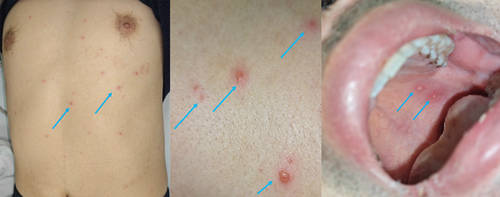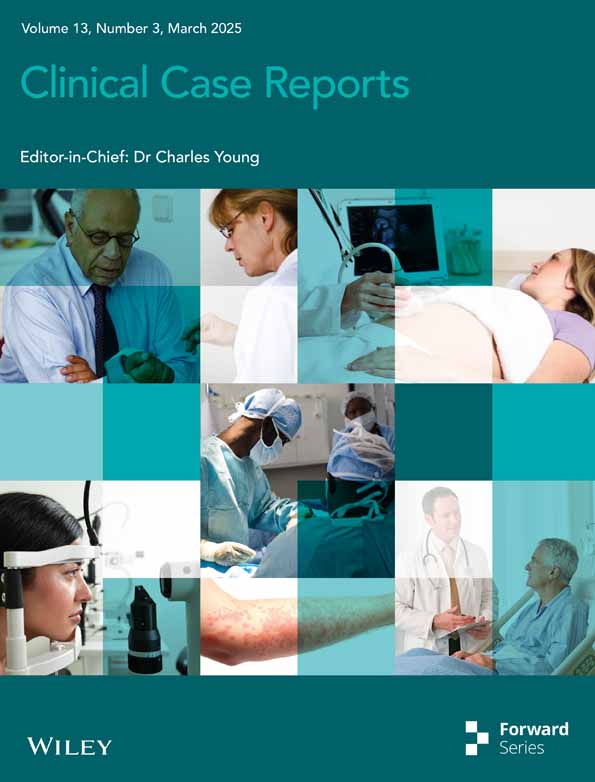Upper Gastrointestinal and Cutaneous Varicella in an Adult Male
Funding: The authors received no specific funding for this work.
ABSTRACT
In this case report, we presented a unique instance of varicella in a 35-year-old male, characterized by both gastrointestinal and skin involvement. This case highlights the importance of recognizing varicella's atypical manifestations, particularly in adult patients with gastrointestinal symptoms, ensuring prompt diagnosis and appropriate management.
1 Case Image Presentation
Varicella is an infectious disease caused by the varicella zoster virus (VZV). It typically presents with fever and a characteristic rash that progresses from macules to papules, vesicles, and ultimately crusting. While the classic presentation is well recognized, atypical manifestations can occur, particularly in immunocompromised individuals. This report discusses a rare case of varicella in a 35-year-old male, presenting with both gastrointestinal and cutaneous involvement.
A 35-year-old male patient presented to the clinic with a 5-day history of upper abdominal pain, worsening over the last day, accompanied by fever. The abdominal pain was initially paroxysmal but progressed to persistent severe discomfort, with a maximum recorded temperature of 38.2°C. The patient reported no significant past medical history or chronic illnesses. Upper gastrointestinal endoscopy revealed esophagitis and erosive gastritis, characterized by multiple vesicles and erosions in the esophagus and stomach, along with surrounding mucosal hyperemia (Figure 1). Despite treatment with rabeprazole, the patient's abdominal pain did not improve. One day later, he developed a centripetal distribution of papules and vesicles on the scalp and back, surrounded by erythema. Oral examination revealed mucosal erosions (Figure 2). Laboratory tests confirmed the presence of VZV IgM and IgG antibodies, leading to a definitive diagnosis of varicella. Viral inclusions were observed in the tissues of upper gastrointestinal biopsies (Figure 1C), further validating our diagnosis. The patient was subsequently transferred to an infectious disease hospital for further management. He received gastrointestinal decompression, acyclovir, and omeprazole. After 1 week of treatment, the vesicles dried and crusted over, his body temperature returned to normal, and abdominal pain resolved.


Varicella is characterized by acute onset, often accompanied by fever and other prodromal symptoms. The rash typically appears 1–2 days after these symptoms. While the classical progression of the rash is well known, atypical presentations can complicate diagnosis, particularly in immunocompromised patients [1]. Generally, gastrointestinal involvement precedes the cutaneous manifestations, posing a diagnostic challenge. Prior research has noted that cutaneous and visceral varicella occurs in 3%–15% of immunocompromised patients with VZV infection, with the gastrointestinal and urinary tracts most susceptible involved [2, 3]. However, this patient did not exhibit any underlying immunological deficiencies. It is worth noting that the patient has never received the VZV vaccine before, which is also a possible reason why varicella affects his upper gastrointestinal tract. Gastrointestinal varicella is rare but can occur, presenting as acute abdominal symptoms [2, 3]. Many patients with gastrointestinal VZV infection may not show typical herpes zoster symptoms when the gastrointestinal signs emerge [2, 3]. Clinicians should be vigilant for atypical presentations in otherwise healthy individuals, as early recognition can lead to timely intervention. The treatment for this disease involves administering sufficient doses of antiviral medications, such as Acyclovir.
This case provides valuable insights into the diverse presentations of varicella, aiding clinicians in the identification and early intervention of this infectious disease. When confronted with a patient presenting with a similar medical history and upper gastrointestinal endoscopic findings, we hope this case will prompt clinicians to consider the possibility of varicella as a differential diagnosis.
Author Contributions
Zhenze Yu: conceptualization, investigation, writing – original draft. Yuan Ding: data curation, investigation. Fang Sun: conceptualization, investigation, writing – review and editing.
Acknowledgments
We thank Dongyu Bai from the Pathology Department of the First-Affiliated Hospital of Xiamen University for assisting us with the pathological analysis.
Ethics Statement
As this is a single case report, ethics committee approval is not required.
Consent
The patient in this manuscript has given written informed consent to the publication of her case details and images.
Conflicts of Interest
The authors declare no conflicts of interest.
Open Research
Data Availability Statement
The data that support the findings of this study are within the paper.




